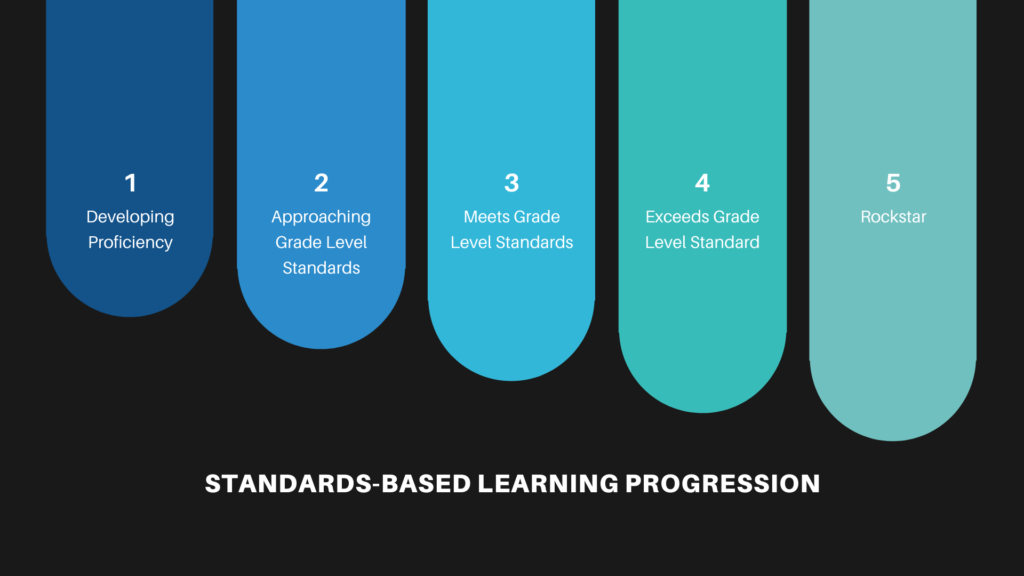Grades.
Few topics in education spurn debates, emotions, and strong views like grades. People have opinions. We get that.
There are many ways to view and understand grades. Different philosophies, pedagogical stances, and political (as in, community politics) views. While many of these philosophies have their strengths, we frequently find ourselves drawn to the KISS principle regarding grades.
The Keep It Simple Stupid Principle*.
First, a Framing
What is the purpose of grades?
Grades are a means to report academic performance. They are a mechanism for relaying what a student knows.
From this starting point, we begin to find significant variance compounded by questions.
- Is the mechanism reliable, or to what degree is the tool reliable? Do grades actually show academic performance?
- How much variance do we see in grades between the student and the grade giver?
- How much variance do we see in grades between teachers?
- How do giving and assigning grades function?
In general, we see two types of grading systems in education. These types are not mutually exclusive, but in terms of framing, they are often considered separate.
Traditional Grading operates with students gaining points or percentages for various assignments and activities. At the end of the grading period, the teacher adds up the points or percentages and assigns a letter grade.
The creation of categories introduces additional complexities that may, or may not, have weights associated with them.
Standards-Based Grading is a method for reporting the progress a student makes towards mastering a curriculum standard.

KISS
When looking at grades through a lens of simplicity, it’s best to start with the stakeholders.
Students are the critical stakeholder of grades, but we also have our fellow educators and, notably, family members. Community and culture matter here as well. A school or district operates in the confines of the local village, with varying experiences, cultures, educational backgrounds, and history.
How do stakeholders understand grades? For many, their frame of reference is how grades worked when they were in school. Letter grades and percentages were (and still are) the norm for many schools.
Simplicity, whether a school uses traditional grading or standards-based grading, increases understanding for stakeholders. That’s not to say schools cannot educate stakeholders on more complex grading initiatives, grading policy variations, etc.. But from a pragmatic perspective, education takes time, and time is a finite resource. Keeping grades simple frees up time.
Examples of The KISS Principle in Practice
With Standards-Based Grading
The technical language of state curriculum standards can often be rather complex and challenging to understand. When schools decide to go with standards-based grading, it helps rewrite standards into a different variation that families and students can understand.
Likewise, simplicity, transparency, and clarity at the higher grade levels of how standards-based grading translates into grade point averages are helpful to families and students. It is best to avoid complex conversions with lots of variables.
With Traditional Grading
A points-by-assignment is the simplest way to communicate a grade. This involves simple addition with a bit of multiplication. The teacher communicates two critical parts of an assignment:
- How many points the assignment is worth.
- How many points the student received.
How many points an assignment is worth is an indicator of the overall value of the assignment. For example, a homework assignment worth 10 points carries less value than a class project worth 100 points.
Weights
Weights introduce complexity into grading and don’t align well with the KISS principle. While we understand why many teachers and schools favor weights because they can help control the overall “value” of assignments, it is far easier to make mistakes with weights and not properly indicate true academic performance.
Teachers usually apply weights to categories. For example, they might have something like so:
- Homework = 10% of the grade
- Classwork = 30% of the grade
- Projects = 20% of the grade
- Quizzes = 5%
- Assessments = 35%
Sometimes you even have weights within weights (i.e., two levels of weights)!
We have witnessed, and some of us have contributed to, many mistakes with weights. The end result is not a true reflection of what a student learned. Moreover, we’ve experienced the struggle of families trying to understand the relationship between specific assignments, grade categories, and weights.
A final note on weights: A simple points-by-assignment does not preclude weights. In the example we mentioned above with homework worth 10 points and a class project worth 100 points, we’re weighing the class project to have more weight. Conceptually, this is far easier to understand for stakeholders.
Are There Times for Complexity?
Absolutely.
Sometimes complexity encourages learning (which is the purpose of education). Sometimes complexity is unavoidable.
That said, we need to be very aware of peoples’ capacity for complexity. Knowing your stakeholders helps in understanding their capabilities.
Also, there are other ways to communicate the complexity of learning without introducing it to grades. We’ve seen educators create excellent “narratives of learning” (frequently shared in family-teacher conferences) that capture students’ learning in ways that are both complex, yet easy to understand. Sometimes reporting on how a student performs academically is best through a conversation.
A Framework that Helps with Communication
The KISS principle of grading is significantly helpful in effectively communicating how students are performing academically. Simplicity encourages understanding, especially between families and students.
The Origins of the KISS Principle
Note that there is no comma between simple and stupid – which means stupidly simple. Other variations include “Keep it Short and Simple”, “Keep it simple and straightforward”, “Keep it simple soldier”.
The term originates with aircraft engineer Kelly Johnson. The principle appears in many other aphorisms and concepts throughout history. Some personal favorites:
“Simplicity is the ultimate sophistication,” – da Vinci
“Make everything as simple as possible, but not simpler.” – Einstein
Related posts:
Service Learning: Partner Participation in Abre
How might schools track and evaluate service opportunities for their students? With Abre, schools have a simple tool they can use to support service learning and community service....
An Introduction to Service Learning and Community Service
Service learning and community service provide many benefits to students and their communities. Join us as we explore this wonderful area of education....
Best Practices for What Works in Education. The Parent Guide.
What are the best practice teaching strategies for parents working with their children at home? We consider five simple approaches to helping students learn outside of the classroom....

